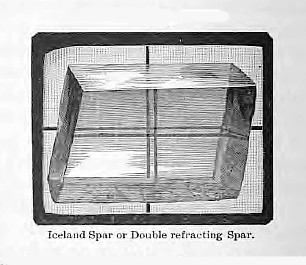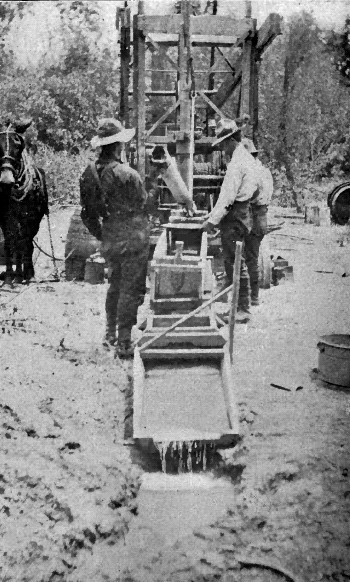PYRITES. Iron pyrites and copper pyrites (chalcopyrite), common in most of our quartz veins in granite and in the eruptive rocks, may yield both gold and silver, but usually the former. There are certain districts more characterized by pyrite than others, such as the Central City district. These are generally gold-producing districts. Some of the mines at Breckenridge and South Park have strong pyritiferous veins in eruptive dykes, such as the Jumbo mine. These have of late produced a great deal of gold. The same district, however, produces large argentiferous lead veins.
Pyrites generally favor the granite, eruptive and crystallized rocks. The quartzites of the Lower Silurian of South Park and Red Cliff are often pyritiferous and generally gold bearing. In limestone the pyrites is rare or absent, its place being filled by some form of iron oxide. In the deeper mines of Leadville, however, this iron oxide is beginning to pass down into the iron sulfide or pyrite from which it was derived. Iron pyrites can generally be distinguished from copper pyrites by its paler, more brassy color, by its superior hardness and by its crystallizing in cubes. Copper pyrites (chalcopyrite) are much yellower and softer, and crystallizes in a more pyramidal form. A vein may glitter with showy pyrites and yet be quite valueless. It usually yields more gold in its decomposed, oxidized condition than in its unaltered state. In the one case the gold is free-milling, and in the other it must be smelted at much greater expense.
SULFIDES. This term
amongst miners is loosely used, and often means some decomposed ore whose
ingredients cannot be determined at sight, but which somehow
assays high in silver. True sulfide or sulfide of silver is a name
embracing a large family of rich
silver ores, among which are
stephanite or brittle silver,
argentite or silver glance, sylvanite or graphic
tellurium, and
polybasite. All these rich ores are compounds of
sulfur and silver and other ingredients in varying proportions. They
are somewhat alike in appearance and not always so easy to distinguish.
ARGENTITE, silver glance, or sulfide of silver, is of a blackish,
lead-gray color, easily cut with a knife, and consists of an aggregate of
minute crystals. Its composition in 100 parts, is sulfur 12.9, silver 87.1.
Under the blow-pipe it gives off an odor of sulfur, and yields a globule of
silver.
STEPHANITE, or " brittle '' or "black" silver, is closely allied to
argentite. Its composition is sulfur, antimony and silver, silver being 68.5
per cent. The crystals are small. Under the blow-pipe it gives off garlic
fumes of antimony and yields a dark globule from which, by adding soda, we
get pure silver.
POLYBASITE, common at Georgetown and in some of the Aspen mines, such
as the Regent or J. C. Johnson, on Smuggler Hill, is like the others, but of
a more flaky, scaly and graphitic appearance. It is not unlike very
fine-grained
galena, yielding 150 to 400 ounces of silver per ton. These
sulfides sometimes line little cavities in limestones with a
dark sooty substance, which under the microscope proves to be crystals of
one of the sulfides of silver. Sometimes also a rock is stained all through
a blackish gray by these sulfides. Iron or manganese may produce much the
same effect, but an assay will soon reveal the difference. Associated with
such a rock we may see flakes or wires of native silver that have emerged
from the sulfide state.
CHLORIDES:
CHLORIDE OF SILVER ("Horn silver,'' or
Cerargyrite). This is another result of secondary decomposition from
a sulfide state (silver sulfide). It is a greenish or yellowish mineral,
like wax, and easily cut with a knife. It is a very rich ore running 75.3
per cent, silver, the remainder being chlorine. As a secondary product of
decomposition it is generally found near the surface or in cavities,
sometimes deposited on calcite or other crystals. In the mines at Leadville
it is commonly associated with other decomposed ores, such as carbonates. In
the Chrysolite mine, a mass weighing several hundred pounds was found.
Chloride, bromide and iodide of silver are closely related, being compounds
of chlorine, bromine, iodine and silver. It is noticeable that these salts
are the elements of sea water, and that these ores are often found in marine
limestones. According to Mr. Emmons, the change at Leadville from sulfide to
chloride was produced by surface waters ; these waters are found to contain
chlorine, which they probably derived from passing through the dolomitic
limestones which contain chlorine in their crystals, and these limestones
perhaps originally derived it from the sea water in which they were
deposited. Chloride of silver is found at Aspen and abundantly in the
outcrop of mines in New and Old Mexico.
SULPHARSENITES.
RUBY SILVER (Pyrargyrite
and
Proustite). Composed of sulfur 17.7, antimony 22.5, silver 59.8=100.
Crystallizes in rhombohedrons, is seen in spots or crystals on a mass of ore
of a deep red or blackish tint. When scratched with a knife it shows a
bright or deep red color. In some mines this very rich ore occurs only as
specimens, but in others it is present in sufficient quantity to largely
influence the value of the ore in bulk. In parts of the Granite Mountain
Mine in Montana, it constitutes the principal ore, associated, however, with
other mineral. It there occurs in large masses and accounts for the
extraordinary richness of that celebrated mine. Proustite is much the same,
only lighter red, and consists of sulfur 19.4, arsenic 15.1, silver 65.5=
100.
CARBONATES:
This term also embraces a large family, the commonest being carbonate of
lead, (cerussite) and carbonate of copper, (malachite
and
azurite). COPPER CARBONATE can never be mistaken, owing to
its brilliant green and azure blue color. Copper stains are among the common
surface signs of a "lead." It is generally associated also with rusty
stains. Both are the surface products from copper and iron pyrites forming a
vein below ground which may or may not be profitable. Copper stains are
common enough in many rocks, but do not always lead to bodies of ore. In
South Park the red Triassic sandstones are so stained, but yield no
copper
ore. Along our foothills there is quite a stained belt from Golden
to Morrison and through Bergen Park. But few promising deposits of copper or
other ores have been found, although handsome specimens of native copper
have been discovered near Golden. At the Malachite Mine on Bear Creek, near
Morrison, a prospect was at one time opened showing a good deal of silicate
of copper (chrysocolla)
and
malachite, but for some reason it has not been worked since.
COPPER in its native or uncombined state is rare in Colorado, and so far, we have as yet no true profitable mine. A great deal of copper is found associated with other ores, and is extracted by some of the smelters. Carbonate of copper is commonest in the limestone districts, as might be expected from the carbonating influence of limestone upon minerals in it, or mineral solutions passing through it. Carbonate of iron (spathic iron, or siderite), constitutes part of the gangue matter in some of our veins, and may also be found associated with coal seams generally, in the latter case in an oxidized condition.
CERUSSITE: (Carbonate of lead). This is mostly found in the limestone districts such as Leadville. It is there known in two forms, one called " hard carbonates," the other "soft" or " sand carbonates." The crystals of this ore are small prisms, sometimes combined into a cross shape, of a pale grayish white, and might be taken for some form of carbonate of lime or gypsum, their weight, however, soon shows the difference. They are a secondary product of decomposition consisting of carbon dioxide and lead oxide; as a carbonate they effervesce in nitric acid, and yield lead when heated. Cerussite is exceedingly rich in lead, carrying 75 per cent. The white lead of commerce has the same composition. In Leadville and elsewhere in Colorado it is may again occur crystals of lead carbonate. Thus the process is from a sulfide to a sulfate, then to a carbonate. The so-called "hard carbonates" is a brown mass consisting of a hard flinty combination of iron oxide and silica, impregnated with crystals of lead carbonate, with which are often -silver chlorides, also. The " sand carbonates'' result from the decomposition and breaking up of the hard carbonates, or from a mass of pure crystals of carbonate of lead, which are, by nature, loose and incoherent. The Leadville mines :are getting below these products of decomposition and entering upon the original sulfides of galena and iron. The yield, however, is said to be equally good.
SPHALERITE (SPHALERITE): " BLACK JACK." Common in most mines mixed with other ores. As it is a very refractory mineral in smelting, much of it is not desirable in a mine. It is easily recognized by its brown resinous look, or when -very black by its pearly luster. At Georgetown, near the surface, brown 'rosin-sphalerite carries silver, and is associated with rich ores, such as polybasite and tetrahedrite. With depth the sphalerite becomes more abundant and .blacker, and loses much of its silver properties. Sphalerite may run from nothing, to twenty dollars silver, and rarely as high as $100 per ton. In some mines in the San Juan it occurs abundantly near the surface and fades out with depth. We have no true zinc mines in Colorado, the zinc being mixed with other ores. In some mines in Pitkin County the zinc predominates over all other ores, and though it runs high in silver the smelters do not care to take it, on account of its refractory character. In the Eastern States where zinc smelting is a specialty, such ore might be separated and both silver and zinc saved. In Missouri, zinc and lead are found together.
Continue on to:
Study Of Rocks For The Prospector, Part I
Return To:
Gold And Silver Basic Prospecting Methods


